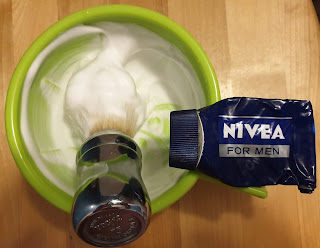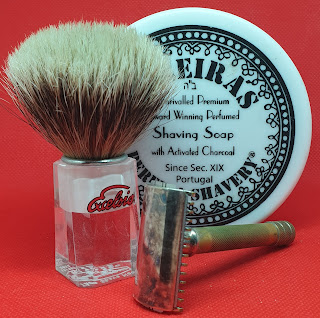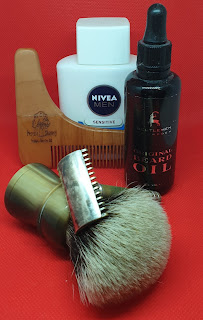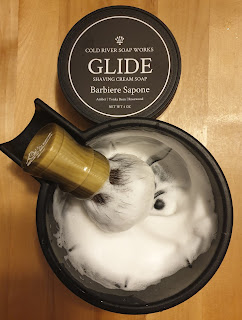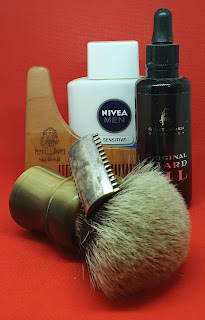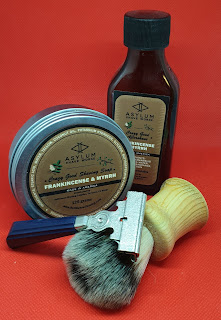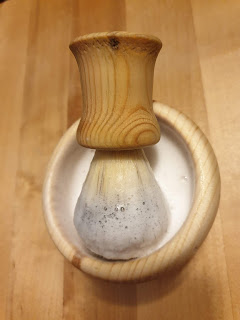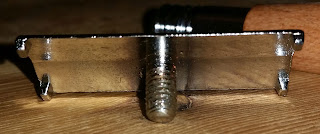Boris Karloff – the actor with the sensitive skin…
Shave of the day 30th October
Morton G Bunnell and the patent for a Gillette Single Edge safety razor
Morton G Bunnell had quite a few patents to his name, but only two razors – and only one of those got assigned to Gillette Co at some point. I think it’s a quite interesting patent, for several reasons.
For starters; it is a patent for a single edge razor – with the patent filed back when Gillette was just getting traction with the double edged blade.
Secondly; it’s for all intents and purposes a single piece razor, although calling it a twist-to-open is stretching the definition a little – or rather a lot.
And thirdly; it’s a patent for a razor without a top cap.
The patent was filed in 1906, but was in limbo for several years until it was finally granted in 1913 – and I have no clue what caused the delay.
The razor is – as can be expected from a single piece, single edge razor – deceptively simple. A handle, containing a spring loaded plunger with a knob on the end to ain in blade removal. A base plate, angled, semicircular cuts in the sides, with a comb on one side as well as a shaped lug in each corner for holding the blade. Blade was inserted and removed by utilising the springiness of the steel, bending it to slip it in under and out from the corner nubs.
Or to quote from the patent text:
…a flat, rectangular, flexible blade having two cutting edges and four corners. The blade is sufficiently flexible that it may be compressed endwise between the thumb and forefinger.
The holder-portion is shown comprising a plate having a flat seat for the blade. Four overhanging lugs, one for each corner of the blade, are shown carried by the plate-portion of the holder.
The holder has the usual guard.
…the blade to be compressed endwise between the thumb and forefinger to such an extent that the ends of the blade will assume a position inwardly of’ the overhanging portions of the lugs at the respective ends and the blade-caused to buckle or hump up from it’s seat and its corners pass inwardly from under the overhanging portions of the lugs and thus be disengaged, from the same. Thus the flexibility of the blade constitutes the expedient by which the blade is inserted and removed…
As a means of starting the upward bending of the blade, the handle is provided internally with a plunger held normally down by a spring. The lower end of this plunger projects at the lower end of the handle. A slight upward pressure on the plunger is sufficient to start the blade and allow it to flex under the pressure of the thumb and forefinger.
Interestingly enough the patent text states that the blade should be double edged, even if it don’t touch upon why. While the ability to turn the blade around and thus have it last twice as long is an obvious reason, I suspect the real reason is that Mr Bunnell intended to use slightly modified Gillette DE blades; squared off instead of rounded edges is the only real change, and there is no reason why Mr Bunnell’s razor couldn’t be slightly changed to accept blades with rounded edges instead of flat. The presence of the two additional holes wouldn’t mean nothing to the operation of the razor. thus allowing this razor to piggyback the infrastructure Gillette already had in place to support their DE razor.
I see no reason why this razor couldn’t be manufactured today, for modern DE blades – in fact the indented corners of the modern blades could actually make it easier to secure the blade under the lugs. The real question becomes; would you want to shave with a razor with no top cap?
Shave of the day 28th October
Shave of the day 25th October
Protector for safety-razor blades, patented in 1907
There are several online shops that sells protectors for your DE razor these days, mostly made from plastic. You can even download a file to 3d-print your own, if you’re so inclined and have a 3D-printer handy. But did you know that the concept is about as old as the Gillette safety razor itself?
The protector for the cutting edge or edges of the blade comprises shield sides bent over to form pockets for enclosing the cutting edges of the blade when the shield is inserted over the back plate, the blade and the guard. This shield is transversely curved as shown and is of such shape that when the arts are drawn into position for use of the shield may be readily slid into and out of its protective position.
In short, the protector would also serve to keep the head and blade assembly together when the handle was unscrewed completely, thus allowing the blade to be kept in the razor even when the razor was packed away in a travel kit or drawer.
Shave of the day 23rd October
Ralph E Thompson’s one-hole razor blade patent
Another one of Mr Thompson’s patents assigned to Gillette Co, this one dates from 1929 and highlights Gillette’s attempts to make a better blade than the original three hole design – a search that didn’t end until Gillette acquired the Probak Corp (and their parent company; AutoStrop Co) and started using the slotted Probak blade we know and love today.
This 1929 patent is trying to address one of the key issues with a safety razor with replaceable blades; the accurate and repeatable positioning of a mass produced, loose tolerance blade in the razor. To quote Mr Thompson in his patent text:
In the use of razors of this type satisfactory operation depends in a large measure upon the accurate positioning of the blade with respect to the cap and guard and the positioning of the cap and guard with respect to each other. A slight inaccuracy in relation of these parts will result in an uneven edge exposure of the blade at different points in its length, or may produce an excessive edge exposure which renders the razor dangerous.
King Gillette originally solved the problem with having three holes that had to line up with three studs. Today we have a stilted blade that can line up with a raised bar, or studs, or a combination. Both designs makes the manufacture of the razor head somewhat complex, since multiple studs or a raised portion has to be machined into the top cap or base plate. A blade with just one hole on the other hand… then you could get ways with just the threaded stud that holds the handle, as shown in the drawing.
A quick sidebar; the razor shown in the drawing looks very much like the Gillette Single Ring as manufactured in the twenties.
So how did Mr Thompson intend for this blade design to easily and accurately align with the cap and guard? By bending the ends of the blade into flanges that would naturally align with the short sides of the base and cap… one turned up, the other turned down. This would – in fact – serve to align the blade, but at the cost of not being able to easily wrap them in paper and pack them flat. Looking at the drawings, the blade was modified from the three hole blade with the rounded sides, which would simplify the production.
It’s hard for me to judge how serious this design was meant to be all the time Gillette was experimenting with a slotted blade at the same time. Possible this was a case of patenting something just to stop the competition from making blades this way, literary throwing stuff at the patent office to see what stuck.
In hindsight there is a better, simpler, and cheaper way to make a razor with just one threaded stud… but I think that in order to see it you needed to be familiar with the modern DE blade; the one developed from the Probak blade with notched corners. It’s clearly shown in the cheap and cheerful razor I bought from Flying Tiger Copenhagen close to two years ago; raised corners on the cap that engage the notched corners, as the photos below shows.
This patent shows an interesting attempt at moving away from the three hole blade before the patents expired, even if the shape would have made packaging more complicated. In the end though I do believe the modern slotted blade is a better solution though, especially as it’s backwards compatible with the older razors originally manufactured for the three hole blade.

